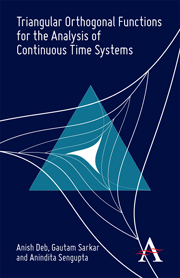Book contents
- Frontmatter
- Contents
- Preface
- Chapter 1 Walsh, Block Pulse, and Related Orthogonal Functions in Systems and Control
- Chapter 2 A Newly Proposed Triangular Function Set and Its Properties
- Chapter 3 Function Approximation via Triangular Function Sets and Operational Matrices in Triangular Function Domain
- Chapter 4 Analysis of Dynamic Systems via State Space Approach
- Chapter 5 Convolution Process in Triangular Function Domain and Its Use in SISO Control System Analysis
- Chapter 6 Identification of SISO Control Systems via State Space Approach
- Chapter 7 Solution of Integral Equations via Triangular Functions
- Chapter 8 Microprocessor Based Simulation of Control Systems Using Orthogonal Functions
- Index
Preface
Published online by Cambridge University Press: 05 June 2012
- Frontmatter
- Contents
- Preface
- Chapter 1 Walsh, Block Pulse, and Related Orthogonal Functions in Systems and Control
- Chapter 2 A Newly Proposed Triangular Function Set and Its Properties
- Chapter 3 Function Approximation via Triangular Function Sets and Operational Matrices in Triangular Function Domain
- Chapter 4 Analysis of Dynamic Systems via State Space Approach
- Chapter 5 Convolution Process in Triangular Function Domain and Its Use in SISO Control System Analysis
- Chapter 6 Identification of SISO Control Systems via State Space Approach
- Chapter 7 Solution of Integral Equations via Triangular Functions
- Chapter 8 Microprocessor Based Simulation of Control Systems Using Orthogonal Functions
- Index
Summary
It all started with Walsh functions, proposed by JL Walsh in 1922 (published in 1923). The orthonormal function set he introduced was very much dissimilar to then reigning sine-cosine functions, because it contained piecewise constant bi-valued component functions. Despite this novelty, the Walsh function attracted little attention at the time, much like its forerunner the Haar function (proposed in 1910).
However, amongst all other piecewise constant basis functions (in simple terms, staircase functions), the Walsh function suddenly became important in the mid-1960s because of its similarities, in essence, with the popular sine-cosine functions and its digital technology compatibility. This function set was a pioneer to generating the interest of researchers working in the area of communication engineering.
In the late 1980s and 1990s, orthogonal staircase functions, like the Walsh function and the block pulse function, encouraged many researchers in terms of successful applications befitting the digital age. However, the researchers, as always, kept on with zeal and vigour for better accuracy and faster computation, and this thriving attitude gave rise to many other orthogonal function sets useful for applications in the general area of systems and control. Yet compared to Walsh and block pulse functions, these new sets had to be satisfied with the back seat.
The orthogonal triangular function set is the result of such a quest, and this new function set has been applied to a few areas of control theory in this book.
- Type
- Chapter
- Information
- Publisher: Anthem PressPrint publication year: 2011



